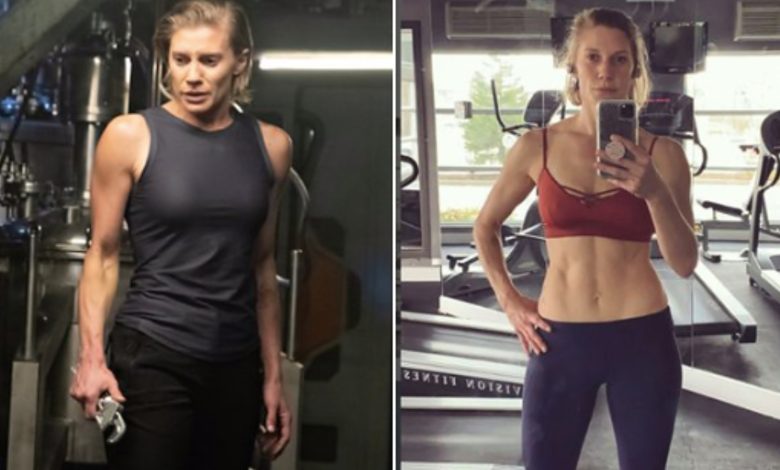Katee Sackhoff Weight Loss Journey Turned Dangerous — Here’s What She Wants You to Know

For many, actress Katee Sackhoff is the definition of strength — both on-screen and off. Best known for her fierce portrayal of Kara “Starbuck” Thrace in Battlestar Galactica and as the resilient Bo-Katan Kryze in The Mandalorian, Sackhoff has long embodied empowerment, discipline, and grit. But behind the Hollywood glam and powerful roles lies a deeply human story — one that involves struggle, obsession, and recovery.
In recent years, Sackhoff has spoken candidly about her weight loss journey, shedding light on the dark side of fitness culture and the dangers of chasing an idealized version of health. What began as a pursuit of fitness and control spiraled into unhealthy territory — a reminder that even the strongest can fall prey to the pressures of perfection.
This is the story of how Katee Sackhoff’s weight loss journey turned dangerous — and what she wants you to learn from her experience.
The Beginning: A Quest for Strength and Control
Katee Sackhoff has always been vocal about her commitment to fitness. From an early age, she was athletic — swimming, running, and participating in sports throughout her youth. Her energy, determination, and intensity made her a perfect fit for action-heavy roles in Hollywood.
When she landed the iconic role of Kara “Starbuck” Thrace in Battlestar Galactica (2004–2009), physical conditioning became a professional necessity. The role demanded endurance, muscle tone, and a certain look — and Sackhoff was all in.
In interviews, she described this period as one of empowerment. Training hard, eating clean, and maintaining her stamina gave her confidence. However, the line between discipline and obsession is often thin, and Sackhoff eventually found herself crossing it.
What began as a desire to stay fit for her roles evolved into an intense fixation on weight loss, calorie control, and physical appearance. Like many women in Hollywood, she faced immense pressure to maintain an image — both for her career and for public perception.
The Hollywood Pressure: When Fitness Becomes a Trap
Hollywood has long perpetuated an unrealistic standard of beauty and body composition, especially for women in leading roles. Despite her success and acclaim, Sackhoff wasn’t immune to these expectations.
In an industry where every red carpet appearance is scrutinized, where casting calls often specify physical “types,” and where social media amplifies body comparisons, maintaining a certain look can become an unspoken job requirement.
Sackhoff has admitted that these pressures led her to pursue extreme fitness routines and dietary restrictions. What made it more complicated was her own perfectionist mindset — the same trait that made her such a powerful actress on-screen also made her vulnerable to overtraining and undernourishment.
At first, it felt like she was winning. The more she worked out, the leaner she got. Compliments from fans and industry peers reinforced the behavior. But inside, she was tired, irritable, and constantly anxious about food and her body.
“It started out as something positive — I wanted to feel strong, healthy, and confident,” Sackhoff later shared in an interview. “But it became something else entirely. It became about control. It became about punishment.”
The Turning Point: When “Healthy” Turned Dangerous
Katee Sackhoff’s wake-up call came when she realized that her relationship with food and exercise had become toxic.
She wasn’t eating enough to sustain her energy needs, and her workouts — often two to three sessions per day — left her depleted. She’d become obsessed with the number on the scale, even when her body was clearly signaling distress.
At her lowest, she struggled with fatigue, dizziness, and hormonal imbalances. Her sleep was irregular, her mood was unstable, and her immune system weakened. Friends and family expressed concern, but like many struggling with disordered eating behaviors, Sackhoff rationalized her actions as “just being healthy.”
In truth, her pursuit of health had turned into a dangerous cycle of restriction and overexertion — one that could have had lasting consequences.
When she began experiencing chronic pain and exhaustion, Sackhoff finally sought medical advice. Doctors warned her that her body was in distress, and that her habits were leading her down a dangerous path. This was the moment she realized that something needed to change.
The Recovery: Learning to Redefine “Health”
Recognizing the problem was just the beginning. Recovery meant unlearning years of damaging beliefs about health, beauty, and worth.
For Sackhoff, this process involved therapy, support from loved ones, and a complete overhaul of her mindset. She began working with professionals who specialized in nutrition, fitness balance, and mental health, focusing not on weight but on overall well-being.
She had to face uncomfortable truths — that she had tied her self-esteem to her appearance, and that societal pressures had deeply influenced her behavior.
Over time, she learned to listen to her body again. She began prioritizing rest, recovery, and nourishment, instead of deprivation. Her workouts became about strength and joy, not punishment or guilt.
Most importantly, she started to speak openly about her journey, breaking the stigma around disordered eating and body image struggles — especially in Hollywood.
“I realized that I had to redefine what ‘fit’ meant to me,” she said in a podcast interview. “It’s not about being the thinnest person in the room. It’s about being the healthiest, happiest version of myself.”
The Mental Health Connection: Beyond the Body
One of the most powerful aspects of Sackhoff’s story is her willingness to discuss the mental health implications of her journey.
For years, she admitted to struggling with anxiety, perfectionism, and self-criticism — issues that often fuel unhealthy behaviors around food and exercise. The more she tried to control her body, the more she lost control of her peace of mind.
Her experience highlights a crucial truth: weight loss isn’t just physical — it’s deeply emotional. Many individuals who fall into similar patterns aren’t just chasing an ideal body; they’re seeking a sense of validation, security, or control in their lives.
Sackhoff’s honesty has helped spark conversations about how mental health and body image are interconnected, especially for women in the public eye. Today, she advocates for greater awareness and compassion, urging others to prioritize mental wellness over aesthetic goals.
The Role of Social Media: The Double-Edged Sword
In today’s world, social media can be both empowering and destructive. For Katee Sackhoff, it became a space to connect with fans — but also a source of intense scrutiny.
As she shared fitness routines and photos, followers often flooded her comments with praise or unsolicited opinions about her body. Even positive feedback reinforced the idea that her worth was tied to her appearance.
Eventually, Sackhoff decided to use her platform differently. Instead of showcasing only her physical achievements, she began sharing candid reflections on her struggles and lessons learned.
She posted about balance, self-care, and imperfection, reminding followers that even public figures struggle with body image. Her vulnerability resonated deeply, turning her platform into a source of authentic empowerment rather than pressure.
“It’s easy to get caught up in comparison,” she said. “But we have to remember that health looks different on everyone. And it’s not always what you see on Instagram.”
Lessons Learned: What Katee Sackhoff Wants You to Know
Today, Katee Sackhoff’s message is clear — health is not about extremes. Her experience taught her several powerful lessons that she now shares with her fans and followers.
1. Listen to Your Body
Your body communicates constantly — through energy levels, hunger cues, and emotional states. Ignoring these signals, as Sackhoff did for years, leads to burnout and imbalance. True health means honoring your body’s needs, not punishing it for being human.
2. Balance Is Key
Exercise and nutrition should enhance your life, not control it. Sackhoff learned to find joy in movement again — running, biking, and strength training — but without the obsession that once consumed her.
3. Don’t Equate Weight with Worth
Sackhoff’s story is a powerful reminder that thinness does not equal happiness. Self-worth should never depend on a number on the scale. Instead, she emphasizes cultivating strength, confidence, and compassion toward oneself.
4. Mental Health Comes First
No diet or workout plan can fix what’s happening internally. Sackhoff’s journey underscores the importance of therapy, self-reflection, and emotional healing in any transformation.
5. You’re Not Alone
By sharing her story, Sackhoff wants others struggling with similar issues to know they’re not alone. Disordered eating, body image struggles, and self-criticism affect millions — and recovery is possible with awareness, support, and self-love.
Inspiring Others: From Struggle to Advocacy
Katee Sackhoff’s transparency has made her an advocate for body positivity and mental health awareness in an industry often dominated by image.
Through interviews, social media, and appearances, she continues to challenge beauty standards and promote a more holistic view of health. Her journey has inspired countless fans who see in her story a reflection of their own battles — whether with food, body image, or self-worth.
She’s also been an active supporter of women’s empowerment initiatives and mental health organizations, using her voice to raise awareness about the dangers of unrealistic fitness ideals.
Rather than hiding her struggles, Sackhoff chose to turn pain into purpose — a decision that has strengthened her connection with her audience and redefined her legacy.
A Healthier Future: Living with Compassion and Strength
Today, Katee Sackhoff continues to train, act, and live with purpose — but on her own terms. Her relationship with fitness is healthier than ever, grounded in self-respect and sustainability rather than self-punishment.
She still loves pushing her body to its limits, but she also knows when to rest. She enjoys nutritious foods but doesn’t deprive herself. And most importantly, she embraces her imperfections, recognizing that true beauty lies in authenticity.
In many ways, her journey mirrors the arc of her most iconic characters — women who are strong yet vulnerable, flawed yet fierce. Just like “Starbuck,” Sackhoff has faced her demons and emerged stronger on the other side.
“I used to think strength was about how much weight I could lift or how little I could eat,” she says. “Now I know it’s about how kind I can be to myself — and that’s the kind of strength I want to live by.”
The Takeaway: Redefining What It Means to Be “Fit”
Katee Sackhoff’s story isn’t just about weight loss — it’s about reclaiming one’s identity from the grip of perfectionism. It’s about realizing that being fit isn’t about deprivation or discipline to the point of damage, but about harmony between body, mind, and soul.
Her journey is a wake-up call for anyone chasing the illusion of the “perfect body.” The truth is, health doesn’t come from extremes — it comes from balance, compassion, and understanding your unique body’s needs.
Whether you’re an athlete, an actor, or simply someone trying to live healthier, Sackhoff’s experience serves as a reminder:
👉 You don’t have to hurt yourself to be healthy.
👉 You don’t have to be perfect to be worthy.
👉 And sometimes, the bravest thing you can do is rest.
Final Thoughts
Katee Sackhoff’s transformation — both physical and emotional — stands as a powerful example of what happens when we prioritize wellness over image. Her willingness to speak about the dangers of extreme dieting, overtraining, and self-criticism has opened the door for more honest conversations in Hollywood and beyond.
Through her vulnerability, she’s helped redefine strength — not as a measure of how much you can endure, but how deeply you can heal.




